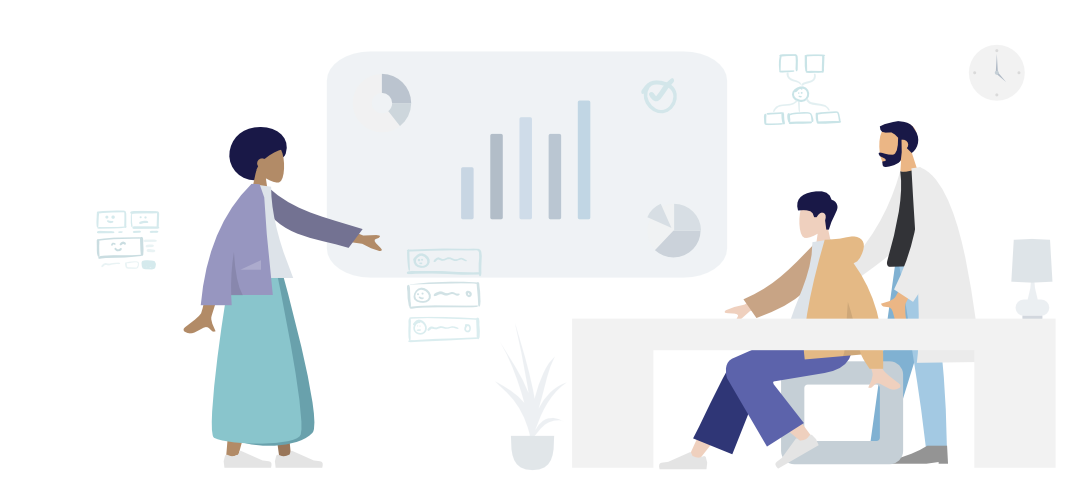Learn Blockchain in Layman's Speak
This is your free almost ELI5 (Explain it like I'm Five) class.
It’s crafted to help you easily understand the tech we use.
We break down complex ideas into simple, actionable knowledge using clear, straightforward explanations.
Course Introduction
Understanding Blockchain and Digital Innovation at Larissa.Health
(This course is for beginners and intermediate learners)
This series is designed to demystify emerging technologies like Blockchain, SSI, Assisted AI, DAOs, and Cryptocurrencies.
No prior knowledge is required—each lesson builds on the last, showing how these technologies shape the future of midwifery and healthcare.
By the end of this series, you will have a clear understanding of how healthcare will evolve in the digital age.
This guide breaks down complex topics into clear, actionable lessons, making them accessible for beginners while providing valuable insights for those already familiar with the field.
TABLE OF CONTENTS
Blockchain – More than just the foundation of cryptocurrencies, blockchain is transforming industries like healthcare and supply chain management. This section covers how it works, why it matters, and how it’s being used in real-world applications.
Self-Sovereign Identity (SSI) – A deep dive into how SSI allows individuals to control their personal data, enhancing privacy and security in an increasingly digital world.
Assisted AI – AI is more than just a buzzword. Learn how AI, Blockchain, and SSI together can create smarter, fairer, and more secure systems.
Decentralized Autonomous Organizations (DAOs) – Governance is evolving. This section explores how DAOs enable decentralized decision-making and why that matters for the future of healthcare and midwifery.
Cryptocurrencies – Beyond being digital money, cryptocurrencies are redefining finance, ownership, and incentive structures. Learn how they function and what role they play in Larissa.Health’s ecosystem.
Next Steps
Each section will walk through these technologies step by step, breaking down concepts, providing real-world examples, and explaining their relevance to Larissa.Health.
You can support our work and earn rewards, by staking to our Cardano Stakepool (Ticker: BIRTH).
This way you will be part of securing the network while contributing to the future of midwifery innovation.
Blockchain Basics
Understanding the Foundation of Digital Ledgers
In this session, we’ll break down what blockchain is and the different types of entities operating the network.
Blockchain is often associated with cryptocurrencies, but it is a powerful technology in its own right. At its core, a blockchain is an immutable database, a digital ledger that records transactions permanently and tamper-proof.
There are many different blockchains today, but they all share the fundamental principle of ensuring trust through decentralization.
How Blockchain Stores and Secures Data
A blockchain is not just a list of transactions. Each block stores information in a way that ensures it cannot be altered once recorded. This data can be:
- Publicly accessible, meaning anyone can verify transactions.
- Privately secured, where only specific users can access and validate data.
However, it’s important to note that blockchains store very little information per transaction.
What About NFTs and Other Large Files?
You may have heard of NFTs (Non-Fungible Tokens)—digital assets like artwork or documents stored on the blockchain. But the full image or file is not stored on the blockchain itself. Instead, the blockchain holds a reference to an off-chain location, along with a cryptographic verification to ensure the content’s integrity.
This means:
- Blocks contain references to external data while maintaining proof that the content remains unchanged.
- Transactions are time-sensitive, as they need to be recorded within specific slots before they are permanently sealed.
Once recorded, blocks are cryptographically sealed and become read-only forever.
The Role of Nodes in a Blockchain Network
A blockchain is not controlled by a single entity. Instead, it is run by multiple independent servers, known as nodes.
Not all nodes serve the same function:
1. Validator Nodes (Full Nodes)
- These nodes actively participate in the network by validating transactions and blocks.
- They enforce consensus rules, prevent fraud, and secure the blockchain.
- Examples include:
- Miners (in Proof of Work blockchains like Bitcoin)
- Stakepools (in Proof of Stake blockchains like Cardano)
- Validators (in various blockchain protocols)
These nodes are rewarded by the blockchain protocol with native tokens, often referred to as cryptocurrencies.
- Bitcoin (BTC) for Bitcoin
- Ether (ETH) for Ethereum
- ADA for Cardano
However, not all tokens are blockchain rewards! Many tokens exist for different purposes and are not generated as part of a blockchain’s validation process.
2. Passive or Light Nodes
- These nodes do not validate transactions but rely on full nodes for blockchain data.
- They query full nodes when needed and are used in applications that interact with the blockchain without requiring the full ledger.
- Examples include crypto wallets and blockchain-based apps.
Why Nodes Matter for Blockchain Security
A blockchain’s security and trustworthiness depend on a network of both full and light nodes.
- Full nodes maintain the integrity and consensus of the blockchain.
- Light nodes provide accessibility and efficiency, allowing users to interact with the network without running full validation.
This redundancy makes blockchain networks resilient, decentralized, and secure.
Public vs. Private Blockchains
Most blockchains are public and permissionless, meaning anyone can participate in validation. But some blockchains are private (permissioned), restricting access based on specific rules.
Why Use Permissioned Blockchains?
A public blockchain wouldn’t be suitable for all types of data—for example, you wouldn’t want your private healthcare records to be openly visible.
This highlights the complexity of blockchain use cases and why different industries are exploring tailored solutions.
As we move forward, blockchain projects worldwide will continue to refine these technologies to solve real-world challenges.
In the next session:
Now that we’ve covered the basics, let’s dive into real-world use cases in our next session.
Uses Cases and Smart Contracts
How Blockchain Solves Real-World Problems
Now that you understand the basics, it’s time to explore how blockchain is used beyond simple transactions. If you haven’t watched or read the previous lessons, I encourage you to check them out first.
Blockchain applications are diverse and transformative, with verified voting, proof of ownership, permissionless financial transactions, and improved documentation being just a few examples.
Let’s take a closer look at how these innovations work in practice.
Verified Voting: Preventing Fraud in Elections
It might be surprising, but history has shown that dead people have cast votes in elections—sometimes even in polls that took place years after their passing.
Blockchain can eliminate this kind of fraud by creating verifiable, tamper-proof records of voter identities and ballots. Every vote can be securely recorded and instantly verifiable, ensuring that election results are accurate and fair.
Improving Documentation in Healthcare and Administration
Accurate and secure documentation is a crucial application of blockchain technology, especially in healthcare.
Blockchain ensures that medical records remain secure, unalterable, and accessible only to authorized individuals. This enhances:
- Privacy – Patients have full control over who can access their medical data.
- Reliability – Records cannot be altered or lost, preventing data tampering.
- Efficiency – Medical history can be securely shared across healthcare providers without compromising patient privacy.
Proof of Ownership: Real Estate, Intellectual Property, and More
Ownership disputes are common, whether in real estate, intellectual property, or digital assets.
Blockchain provides a clear, unalterable record of ownership—like a digital title deed that is secure and easily transferable.
This eliminates intermediaries, reducing:
- Time delays in transfers.
- Costs associated with third-party verification.
- Trust issues, since blockchain ensures transparency in ownership history.
Permissionless Financial Transactions: Borderless and Inclusive Payments
Blockchain enables secure, global financial transactions without relying on banks or financial institutions.
Transactions can be:
- Instant and cost-effective, avoiding high banking fees.
- Accessible to anyone, even in regions without traditional banking infrastructure.
- Unstoppable, meaning no one can arbitrarily freeze or block your funds.
And if you’ve earned rewards from delegating to a blockchain node, you can use those tokens for transactions—but more on that in a later session!
Smart Contracts: Automating Transactions Without Intermediaries
Traditionally, platforms like PayPal or banks act as intermediaries to ensure smooth transactions. However, they:
- Can have downtimes and stop working.
- Can block transactions at any time.
- Charge fees for acting as the middleman.
With blockchain, transactions can be executed without intermediaries using smart contracts.
What Are Smart Contracts
Despite their name, smart contracts aren’t actually smart. They are simply pre-programmed rules that automatically execute transactions when conditions are met—just like a traditional contract.
A smart contract:
- Has no downtime – It’s always available on the blockchain.
- Operates with full transparency – Anyone can read the contract’s code.
- Ensures fairness and neutrality – No single party controls it.
For smart contracts to be trustworthy, they should be open-source and well-documented, allowing anyone to verify their rules, just like traditional legal agreements.
What’s Next?
Now that we’ve covered real-world blockchain applications, you might be wondering:
Can you earn rewards in the blockchain and crypto ecosystem?
That’s exactly what we’ll explore in the next session—along with common misconceptions about earning in crypto.
Privacy, KYC, and Self Sovereign Identity
Understanding Digital Identity on Blockchain
In this session, we’re covering Blockchain Privacy, Know Your Customer (KYC), and Decentralized Self-Sovereign Identity (SSI). These concepts are deeply interconnected, shaping how digital identity works in a decentralized world.
If you haven’t gone through the previous lessons, it’s recommended to check them out first. Let’s dive in.
Blockchain Privacy: Is Blockchain Really Anonymous?
A common misconception is that blockchain transactions are anonymous. In reality, most blockchains are pseudonymous—meaning transactions are public but not directly linked to real-world identities.
On public blockchains like Bitcoin, Ethereum, or Cardano, transactions are transparent and traceable. Think of it as having a bank account that everyone can view, but your name isn’t explicitly attached.
To enhance privacy, many users:
- Use multiple wallet addresses, similar to having different bank accounts.
- Rely on privacy-enhancing technologies, such as:
- Ring Signatures – These act like a digital disguise, making it difficult to track who initiated a transaction.
- Zero-Knowledge Proofs (ZKPs) – These allow verification of transactions without revealing sensitive details.
However, privacy on blockchain is not absolute. With enough analysis, patterns can emerge, revealing connections between transactions and users.
Know Your Customer (KYC): The Role of Identity Verification
KYC is a standard procedure in financial systems, requiring individuals to verify their identity when opening bank accounts or using financial services.
Why is KYC Important?
- Prevents financial crimes, such as money laundering and fraud.
- Ensures compliance with regulations and sanctions.
- Aids taxation and risk management for businesses and governments.
However, KYC also has challenges. While it helps enforce laws, it can exclude individuals who lack access to traditional forms of identification.
Blockchain and KYC – Some countries, like Estonia, use blockchain-based identity solutions to make KYC more efficient and accessible. Once verified, users can securely interact with financial and legal systems without repeatedly proving their identity.
KYC in Digital Midwifery
Applying KYC to midwifery ensures that midwives are verified professionals, creating a trusted and secureenvironment for both midwives and patients.
Self-Sovereign Identity (SSI): Controlling Your Own Digital Identity
SSI is a privacy-first approach to identity verification. Instead of exposing all your personal information, SSI lets you share only what’s necessary.
How Does SSI Work?
- Imagine proving your age at a movie theater. Instead of showing your ID (which contains your name, address, and birthdate), SSI allows you to prove you’re over 18 without exposing any other information.
- Instead of storing identity data in centralized databases, SSI puts control in your hands.
Decentralized SSI: The Next Step
Traditional SSI systems still rely on centralized organizations to store data. Decentralized SSI takes this further by using blockchain and cryptographic references for verification.
- Decentralized Identifiers (DIDs) store a reference to your identity on the blockchain.
- This reference is verified using DID documents, which act as immutable records to confirm status or identity without revealing private details.
With Decentralized SSI, you decide:
- Who gets access to your data
- What information you share
- When and where it is used
This level of privacy and autonomy is why blockchain communities favor SSI for digital identity solutions.
Balancing Privacy, Security, and Responsibility
With great control over your digital identity comes responsibility. Here’s a rule of thumb:
- The more decentralized a system is, the more secure and censorship-resistant it becomes.
- However, decentralization can reduce convenience and increase personal responsibility.
If you lose access to your wallet or SSI credentials, your data could be lost forever. Unlike traditional systems, there is no "forgot password" recovery option.
This means users must:
- Back up their digital keys securely.
- Take extra care in managing their SSI data.
Privacy, transparency, and decentralization are all interconnected, and blockchain offers a new approach to identity verification that empowers users rather than relying on centralized entities.
What’s Next?
With a solid understanding of blockchain privacy, KYC, and SSI, we’re ready to dive into how users can earn rewards in blockchain ecosystems—and some of the most common misconceptions about crypto earnings.
Sustainable Cardano Staking
Support Decentralization and receive Staking Rewards
Cardano Staking really embraces the concept of true financial ownership and allows you to support your favorite projects at the same time.
One part of staking is the expectation of rewards; the other part is supporting the growth of the blockchain ecosystem.
By splitting your stake delegation between the best-yielding Stakepool and your favorite projects, you achieve both to a sustainable maximum.
Why Sustainable Staking Matters
High-yield stake pools may maximize short-term profits, but they don’t necessarily sustain the ecosystem.
Many innovative projects operate their own stake pools as a funding mechanism—despite pressure from large ADA holders to consolidate into a handful of so-called "optimal" pools.
If staking were solely driven by yield, Cardano’s development landscape would shrink, leaving only pools optimized for returns, not innovation. A blockchain without thriving projects lacks intrinsic value, ultimately discouraging both developers and investors—no matter how often technocratic or pseudo-scientific arguments claim that “pure decentralization” and “security” alone are enough.
Moreover, the k-parameter excess (when pools surpass their saturation limit) serves as a clear indicator of network growth potential, much like a company's increasing valuation. It reflects strong demand for staking beyond current constraints, reinforcing the need for wider distribution, not just "efficient" delegation.
By supporting mission-driven stake pools, delegators ensure Cardano remains a fertile ground for new development, fostering long-term value that extends beyond just APY percentages.
The non-custodial Cardano Staking
Staking on Cardano is very different from other blockchains. It is non-custodial, so your ADA never leaves your wallet. On top of this, you will be able to move your ADA between each delegation snapshot.
Staking and Payouts on Cardano
Cardano is counting in epochs. An epoch has five days, and staking decisions are offset by 2 epochs (10 Days).
At the end of each epoch, a snapshot of your staking status is taken. These delays are meant to reduce malicious and opportunistic behavior.
In simple words: 10 days after your delegation epoch, the Cardano network acknowledges your ADA delegation as a vote of confidence, and on day 21, you will receive your first reward payout. All is automated by the network.
Therefore, if you switch from another Stakepool to BIRTH, you will be eligible for rewards from BIRTH in 2 epochs (10 days). You won't lose rewards during the transition period.
Course Introduction
Understanding Blockchain and Digital Innovation at Larissa.Health
(This course is for beginners and intermediate learners)
This series is designed to demystify emerging technologies like Blockchain, SSI, Assisted AI, DAOs, and Cryptocurrencies.
No prior knowledge is required—each lesson builds on the last, showing how these technologies shape the future of midwifery and healthcare.
By the end of this series, you will have a clear understanding of how healthcare will evolve in the digital age.
This guide breaks down complex topics into clear, actionable lessons, making them accessible for beginners while providing valuable insights for those already familiar with the field.
TABLE OF CONTENTS
Blockchain – More than just the foundation of cryptocurrencies, blockchain is transforming industries like healthcare and supply chain management. This section covers how it works, why it matters, and how it’s being used in real-world applications.
Self-Sovereign Identity (SSI) – A deep dive into how SSI allows individuals to control their personal data, enhancing privacy and security in an increasingly digital world.
Assisted AI – AI is more than just a buzzword. Learn how AI, Blockchain, and SSI together can create smarter, fairer, and more secure systems.
Decentralized Autonomous Organizations (DAOs) – Governance is evolving. This section explores how DAOs enable decentralized decision-making and why that matters for the future of healthcare and midwifery.
Cryptocurrencies – Beyond being digital money, cryptocurrencies are redefining finance, ownership, and incentive structures. Learn how they function and what role they play in Larissa.Health’s ecosystem.
Next Steps
Each section will walk through these technologies step by step, breaking down concepts, providing real-world examples, and explaining their relevance to Larissa.Health.
You can support our work and earn rewards, by staking to our Cardano Stakepool (Ticker: BIRTH).
This way you will be part of securing the network while contributing to the future of midwifery innovation.


